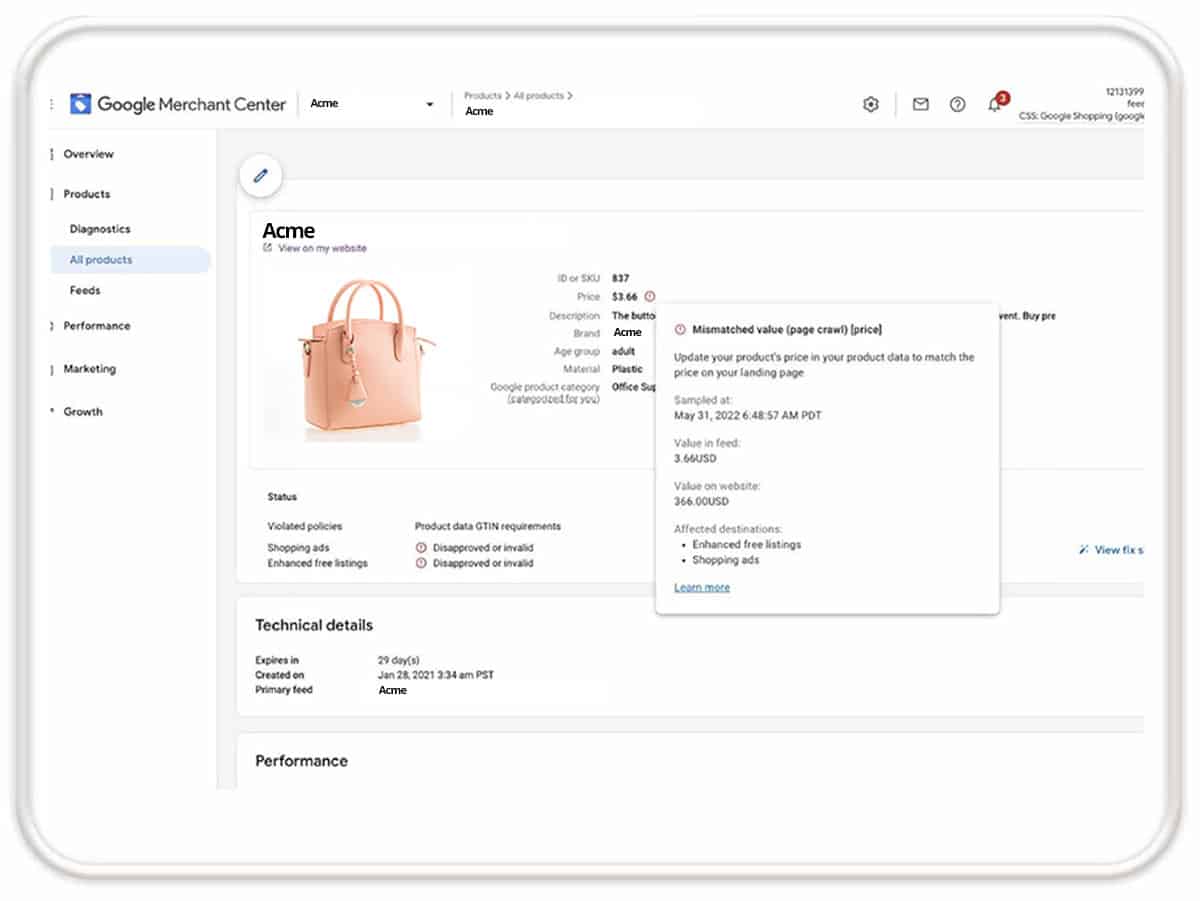Imagine your disappointment after clicking on a Google Shopping ad for a product you were excited to buy, only to find a different price on the website product page, or even worse, on the checkout page.
![Mismatched value (page crawl): (price [price])](https://highstreet.io/wp-content/uploads/2022/06/GMC-Price-Mismatch-Landing-Page-Example-1.jpg)
This is the exact experience Google Shopping aims to prevent. On April 6th, 2021, they took their already strict “Google Price Mismatch” landing page requirements and applied them to eCommerce checkout pages. The error message called “Price Mismatched value (page crawl): (price [price])” is a common issue advertisers encounter in Google Merchant Center (GMC).
Your competition to attract buyers is increasing and it’s tempting to use tactics like dynamic pricing to increase conversions. Google recommends not changing prices based on cookies, browsers, devices, or any other factors. Instead, they suggest using regional pricing and availability if you only target certain locations within a country.
Fix your price mismatch errors in your GMC account with these easy-to-follow tips and learn more about:
- What Causes Price Mismatch Disapprovals & How to Fix Them
- Risks of Having Price Mismatch Values
- How to Use Google’s Automatic Item Updates to Help Price Mismatch Issues
- How to Prevent Price Errors With the Right Tool
What Causes Price Mismatch Disapprovals and How to Fix Them
A price mismatch disapproval in Google Merchant Center happens when there is an inaccurate price status due to an inconsistency between your Google Shopping feed and the product pricing on your website.

Example of a Google Merchant Center (GMC) Price Mismatch Error
Product pricing best practice involves being consistent across all your selling and advertising channels. This includes your product listings in social commerce, marketplaces, shopping ads, and your website.
Reaching this goal when you have many product listings and ads can be challenging but not impossible.
Possible reasons for a price mismatch error and Google’s suggestions on how to fix it
- A sale has started or ended but the price in the feed hasn’t been updated; as a result, the sale price effective date is wrong.
Additionally, ensure the value for the sale price effective date [sale_price_effective_date] attribute is aligned with the timing of changes to your site. - Multiple prices on the landing page: Shopping supports two prices, the price and the sale price (which are indicated using the price [price] and sale price [sale_price] attributes).
If more than one price is present, make sure the lowest price is the most prominent and is listed using the sale price [sale_price] attribute. - Use of IP detection and dynamically changing prices: Don’t change the price of your product on your landing page based on a user’s location.
Additionally, do not change the price based on cookies, browsers, devices, or any other factor. If you only target certain locations within a country, use regional pricing and availability. - Outdated microdata or HTML: Check for contradictory information within your site build, and remove it to eliminate crawling issues.
- Minimum order quantity and bulk products: If the shopper must purchase a minimum number of products, such as 10, list the total price for 10 products.
Don’t submit the price for a single product if a minimum number of products is required. - Title, description, or image mismatch: Make sure that the product featured in your title, description, and image matches the price you submit.
For example, if the product description mentions “an engraved product” and the image features a customized product with an engraving, make sure the price in the feed includes engraving fees. - Variant preselection and price ranges: Ensure each variant in the feed has a URL that loads to a pre-populated page of that variant.
For example, if you advertise a premium flower bouquet, make sure the price in your feed is for the premium variant and the same premium variant is preselected on the landing page. - Handling fees: If you have additional logistical fees, rather than bundling them into the price variant, list them on the site as “shipping”, “delivery”, “handling”, “logistics”, or “carrier” and bundle the cost into the shipping [shipping] attribute.
- Dynamic population and page load times: If a price is calculated dynamically and then added to the landing page, or if the page has a slow load time, the crawlers may miss the final price. Make sure to load your price on the landing page immediately.
If none of the above scenarios, provided by Google, apply to your price mismatch issue, Google’s more recent advice suggests “If the price of a product advertised in a Shopping ad or free product listing is different from the price shown in a customer’s shopping cart, that could create a negative experience for the customer and could result in the loss of a sale.”
Get more details about check-out requirements and best practices on the Google Merchant Center Help page.
Requirements to ensure your product’s price is clear
- The price of your product should be consistent throughout the checkout process, not just between the product feed and your landing page. The price shouldn’t increase at checkout, but it may be reduced after the product is added to the cart if a promotion is added.
- Any additional fees charged during checkout must be disclosed in Merchant Center by bundling them with the applicable shipping costs.
For example, service fees, handling fees, carrier-related fees, and state fees must be included in the total value submitted in the shipping [shipping] attribute or using the Merchant Center shipping services. - Many countries, such as Argentina, Brazil, and Italy, require a value-added tax (VAT) which must be included in your price [price] attribute.
- For the US, sales tax must be clearly stated in the feed attributes or your account-level settings.
Overestimating sales tax in Merchant Center is allowed, but taxes can’t be higher at checkout than those listed in Merchant Center. - Shipping costs are submitted separately, either in your feed or at the account level. Note that feed-level rates will override account-level settings.
You can overestimate shipping rates in the Merchant Center as long as they’re not higher on your website at checkout. - If you require a minimum basket amount for a customer to qualify for free shipping, make sure to set up your shipping settings on the account level and use the “free shipping over a certain amount” option.
- If you charge a minimum basket amount surcharge on top of the shipping cost, make sure the surcharge is included in your shipping settings. It’s recommended that you use the range-based shipping setup.
More Details on How to Fix Price Mismatch Errors
Once you’ve worked with your product feed provider or troubleshot the issue on your own with the suggestions detailed above, schedule a feed update for Google to re-crawl your website with your updated pricing.
Additional Tips:
- Apply frequent product feed refreshes
- Use delta feeds to increase feed update frequencies (delta feeds or APIs)
- Update promotions with validity dates
If you have reviewed all of the tips to resolve your price mismatch issues and you’re still getting the error, you may need to get a developer to update your website source code for Google to re-crawl the correct price attribute on the page.
Risks of Having Price Mismatch Values
Now that you know the reasons for the error, it’s important to understand the short-term and long-term effects of continual price mismatch values in Google Merchant Center.
- The most serious long-term risk of having too many products with incorrect prices is a permanent account suspension. This could happen if you haven’t fixed your price mismatch issue within 28 days from receiving the notification in Google Merchant Center.
- Having too many products disapproved may also lead to a reduced number of offers available for a Google Shopping campaign.
- A shorter-term risk, but equally as serious as an account suspension, is providing a negative shopping experience to your customers. If Google doesn’t catch mismatched values and a customer sees a different price on a shopping ad compared to your website, this could lead to fewer people clicking on your ads or completing a purchase on your website.
How to Use Google’s Automatic Item Updates to Help Price Mismatch Issues
Google Ad’s Automatic Item Updates are used to improve the quality of your data and provide a good user experience for shoppers. This option is set up by default and must be manually turned off if merchants don’t want their mismatched pricing to be updated automatically.
Best practices Google Ads provides on their Help page to get the most out of their Automatic Item Update feature include:
- Schedule feed uploads or updates via the Content API immediately after the products have been updated on your website.
This will help you avoid errors due to the time difference between updates on your website and updates of your Shopping data. - If you’re using the sale price [sale_price] attribute, make sure that the period in which the sale is active is specified correctly with the sale price effective date [sale_price_effective_date] attribute and that the timezone is correct. When a sale is active, the sale price is shown as the current price in Shopping search results.
- For products sold in bulk quantities, you should submit the total price for the minimum number of products sold.
Landing pages must list prices in the appropriate currency of the target country and the same currency as submitted in your product data. - To detect and update mismatches, Google crawls the landing pages listed in your data feed or provided in the Content API.
You can increase Google’s crawl rate to allow us to cover more products on your website
Pros of Automatic Item Updates
- If mismatched prices are fixed automatically, shoppers will enjoy a better experience which means more traffic to your products and higher conversion rates
- Ads that would have been disapproved can still run
- Advertisers don’t have to worry about errors as they resolve the price mismatch warnings
Cons of Automatic Item Updates
- Relying on Google automatically updating your prices isn’t a long-term solution for regularly updating your product data
- If too many mismatches occur, your automatic item updates will stop working and your account could be at risk of suspension
- Google’s crawler may not be able to detect the correct prices (often because of price dropdowns for multiple sizes) and apply the wrong prices, even if feed data is correct
Prevent Price Mismatch with the Right Tool
Using the right product feed tool and service can help you avoid ongoing price mismatch errors that affect your marketing performance and put you at risk of account suspension.

Highstreet.io GMC Diagnostics Warning/Alert Features
At Highstreet.io we provide master feed and channel-specific feed optimization services for channels like Google Shopping.
Fix price errors in your feeds with:
- Diagnostics support that notifies customers with reports and alerts about significant numbers of price mismatch errors
- Optimization techniques that improve your feed data’s structure related to product variants, such as color, size, and minimum order requirements to minimize price mismatches
- Frequently scheduled and fast feed updates with delta feeds so Google is always matching the correct product data with your website
- Summary emails of all outstanding issues to customers generated programmatically with our GMC Diagnostics API connection
Part of the optimization process is ensuring that your product information is complete with quality, up-to-date and accurate data. This is especially important to avoid price mismatch issues in your Google Merchant Center (GMC).
Ensure the accuracy of all the data in your product feed. Reach out to our experts and get your product data optimized for Google Merchant Center with Highstreet.io.

